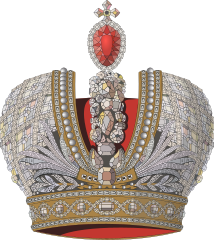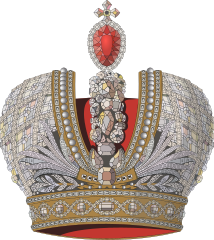This is a look through Russian history from the first known ruler: Rurik (reigned 862-879) to the tragic last Tsar: Nicholas II (reigned 1894-1917). We’ll judge them all: the Great, the Terrible and those in-between. How long did they last, what did they achieve, did they leave Russia a better and safer place than they found it and to what extent have they made a mark on the world? We shall find out – on Rate My Tsar.
I was inspired to create this by three excellent podcasts which I wholeheartedly recommend:
Saga Thing, about Icelandic sagas; Rex Factor, rating Kings and Queens of England and Scotland; and Totalus Rankium, who rate Roman Emperors – all of them, all the way to 1453.
If my work is 1/10 as good as theirs, it will still be worth reading.
I will judge the rulers of Russia on four main criteria:
- Length of rule. A long reign is not always a sign of success, but being chased out of power or murdered after a palace coup is definitely a sign of failure. Longer is better. For the early period, where there was a rotation between semi-independent principalities before the senior prince finally got to Kiev, I’ll give them 1/3 points for each year as Knyaz’ (Prince), and full points for years as Veliky Knyaz’ (Great Prince).
- Achievements. This might cover a large number of possibilities over the 1000 + years of the Russian monarchy: founding cities, building churches, publishing law codes, patronising scholars, or sending an army to the gates of Constantinople, whether in the 9th century or the 19th.
- Leaving the country in a better state than they found it. Did a given ruler strengthen defences, maintain law and order, improve culture and raise the prestige of the Russian state? If so, they’ll get a good mark here.
- Fame and glory. I asked a few educated, professional people in the UK if they could name any Russian monarchs. My conclusion is that Russian monarchs aren’t very well known in the UK. To judge this section, I counted into how many languages a ruler’s biography was translated on Wikipedia. However, Wikipedia seems to be a bit biased towards modern rulers, so I’ll add some extra bonus points for earlier rulers with name recognition in their homeland, but who don’t seem to have an impact outside. Saints also get extra points – they built up their treasure where neither moth nor rust destroy, nor thieves break in and steal. They have their reward, but I’m going to give them another one.
- Reflected glory. I wanted to add extra points for ruling at a time when remarkable people flourished, but recognise that for earlier rulers, the records simply aren’t there to judge them fairly and that later rulers might benefit from systems they didn’t set up. They won’t get extra points, but they do get a bit of reflected glory.
There are a few points I’d like to clarify before I start.
- Rate my Veliky Knyaz’?
Only a handful of Russian monarchs were officially titled Tsar. The word Tsar (Царь) is derived from Caesar and was used to refer to the Roman (either Byzantine or Holy Roman) Emperors in the Middle Ages as well as the Khan of the Golden Horde. The rulers of Kiev, Vladimir and finally Moscow were generally known as Great Prince in English (Veliky Knyaz’ / Великий Князь) in Russian). Knyaz’ actually derived from the Germanic word that became King in English, but in the Russian context, it is normally translated as Prince.
Yaroslav I of Kiev (11th century) was referred to as Tsar on an inscription made after his death, Mikhail of Tver (13th century) used the title while in conflict with the Golden Horde, to demonstrate his temporary independence from Mongol vassal status. However, the title was only permanently used by Russian rulers after the fall of the Eastern Roman Empire in 1453, Ivan III’s marriage to Sophia, niece of the last Roman Emperor and his refusal to pay tribute to the Khan of the Great Horde in 1476. The title was still, to some extent, informal, until his grandson, Ivan the Terrible was officially crowned Tsar at the tender age of 17, in 1547.
Claiming equality of status with Solomon, Augustus, Justinian, Charlemagne and Genghis Khan just isn’t good enough for some people, or rather the term Tsar doesn’t seem quite Western enough. You might be guessing who I’m referring to at this point. That’s right – Peter the Great. He wanted to use a proper European title, so he redefined himself as Imperator. So, starting from 1721, the rulers of Russia weren’t officially Tsars either.
2. That’s not how you spell that!
If you speak Russian, or are very observant, you might have noticed I used an apostrophe to mark the soft sign at the end of Knyaz’, but not the one at the end of Tsar(‘). I also referred to Mikhail of Tver as Mikhail, not Michael (and I missed off the soft sign in Tver as well), but Pyotr Veliky as Peter the Great. That’s largely because I’m going to be using spellings as I am used to seeing them in English. You tend to see Romanovs’ names spelled as if they were English, especially Peter the Great and afterwards, while previous rulers often get their names transliterated, not translated, so Ivan the Terrible’s father is Vasily, not Basil.
If I’m not used to seeing a name, personal or geographical, spelt in English, I’m going to spell it the way I think best reflects the pronunciation.
In some cases, in particular the case of Kiev, the seat of the Great Prince for the first few centuries, there is a current political argument about how it should be spelt. I’m going for Kiev, because it is the way I am used to seeing it spelt in English, and I am covering Russian history up to 1917 – 18, not post-Soviet history since 1991. From what I have seen, no-one in the West knows enough Ukrainian to know how to pronounce “Kyiv” properly anyway. To be even-handed, I won’t be spelling the current capital of the Russian Federation as “Moskva” either.
3. But (city X) is in (country Y) now!
Obviously, with a war (or Special Military Operation) going on, there is a lot of passion around borders, national identity etc. in connection with the three states that are the most obvious successor states to ancient Russia. The earliest references to an Eastern Slavic nation / state talk about the Rus’ (Роусь in Old Slavonic) as a people, the country as “Russian land”.
Rather than anachronistically referring to a city as being in the country it is in now, or starting off calling the state Rus’ then changing, I will generally be referring to areas that are under the authority of the monarch being discussed, as being in Russia. This will eventually include Alaska. I’ll try to put a link to Wikipedia for cities when mentioned the first time, so you can go and have a look at where it actually is and what it is like at the moment. I am making no comment on where I think the current borders of the Russian Federation, or any other country, should be. I would refer to Londinium as having been in Britannia, not in England – it doesn’t mean I necessarily want to see the UK as part of the Roman Empire again.
4. Byzantine vs Roman.
In order to differentiate the earlier, mainly Latin speaking Romans from the period after the chaps in the West dropped the ball, but those in the East didn’t, historians invented the name Byzantine Empire. The Romans in the East NEVER called their country that. NEVER. Even after WW1, when Greek armies moved into areas of the Ottoman Empire with Greek speaking populations, the people there identified not as Greek, but as Roman. The term has died out, as the more westernised elites identified as Hellenes and Roman acquired a sense of “country bumpkin”. Sad really, but I’m not joining in. The Empire ruled from Constantinople (and Nicaea for a bit after the 4th Crusade) is Roman, except where described in Russian or other sources as Greek.
Bibliography
I’ll add to this as time goes on. Wikipedia is a nice place to start, but the proper books I’ve been using are as follows:
Akunin, Boris. (as of 18th December 2023 officially on the list of terrorists and extremists after saying the quiet bit out loud in great detail on a prank call from Lexus and Vovan), Chast’ Yevropy: Istoriya Rossiyskogo Gosudarstva ot istokov do mongol’skogo nashestviya. Moscow, 2014.
Likhachev, D. S. and Tvorogov, O. V. (translators). Povest’ Vremmenikh Let. St-Petersburg, 2012.
Pashkov, B, G. Rus’ – Rossiya – Rossiyskaya Imperiya. Khronika pravleniy i sobytiy 862 – 1917 gg. Moscow, 1997.
Shishov, Aleksey. Russkiye Knyazya. Rostov na Donu, 1999.
Shletser, Avgust (editor). Ruskaya Letopis’ po Nikonovu spisku. St. Petersburg, 1767.


Leave a comment